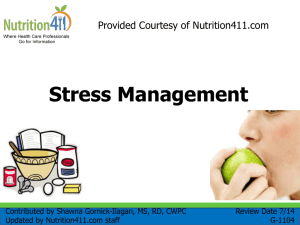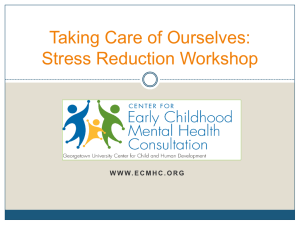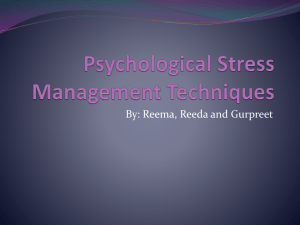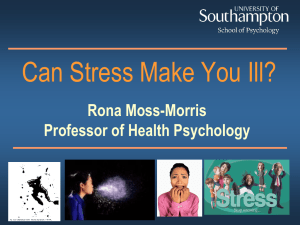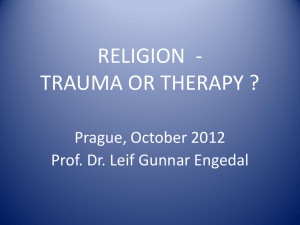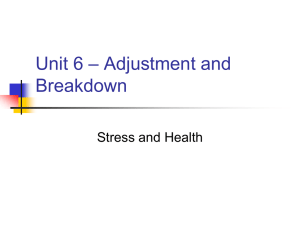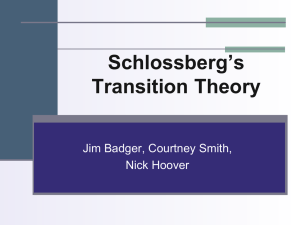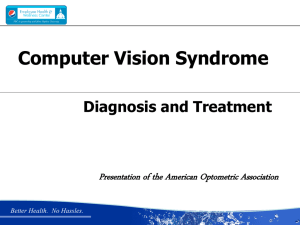Stress
advertisement
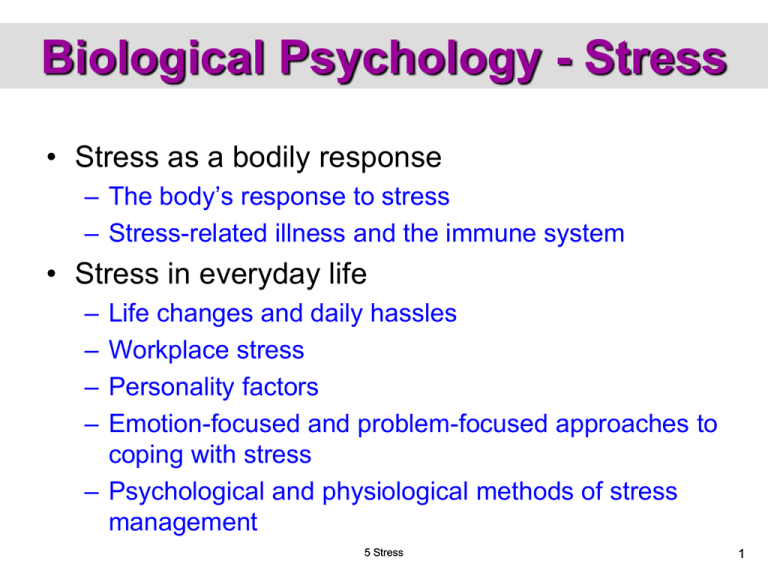
Biological Psychology - Stress • Stress as a bodily response – The body’s response to stress – Stress-related illness and the immune system • Stress in everyday life – – – – Life changes and daily hassles Workplace stress Personality factors Emotion-focused and problem-focused approaches to coping with stress – Psychological and physiological methods of stress management 5 Stress 1 Definitions of Stress 1. A response (e.g. physiological response) to something in the environment 2. A stimulus (stressor) in the environment 3. A lack of fit between perceived demands and perceived ability to cope with these demands – this is the definition most often used by psychologists and called the transactional approach 5 Stress 2 Topic 1: Stress as a Bodily Response • The body’s response to stress • Stress-related illness and the immune system 5 Stress 3 Body’s Response to Stress • • • • • Pituitary adrenal system Sympathomedullary pathway Activating the body’s stress-response General Adaptation Syndrome Gender differences in the stress response 5 Stress 4 Hypothalamic-Pituitary- Adrenal System • This system involves the adrenal cortex and is under the control of the hypothalamus and the pituitary gland – Brain evaluates a situation as stressful – Brain instructs hypothalamus to release corticotrophin releasing factor (CRF) – CRF travels to pituitary gland – Pituitary gland releases adrenocorticotrophic hormone (ACTH) which travels to the adrenal cortex and stimulates the release of hormones called corticosteroids into the bloodstream 5 Stress 5 Hypothalamic-Pituitary- adrenal System 5 Stress 6 Sympathetic – adrenal-medullary Pathway • The adrenal medulla is controlled by the autonomic nervous system (ANS), a network of nerve pathways running from centres in the lower parts of the brain (the brainstem) out to the organs of the body • The ANS is controlled by brain structures such as the hypothalamus • The ANS has two subdivisions – – the sympathetic, and – the parasympathetic • When the sympathetic subdivision is activated, heart rate and blood pressure increase; fats and carbohydrates are mobilised; activity in the digestive tract slows down – a pattern known as sympathetic arousal • When the parasympathetic subdivision is activated, heart rate and blood pressure return to normal and digestion speeds up – a pattern of calm and bodily relaxation 5 Stress 7 Sympathomedullary Pathway (cont.) • When sympathetic branch of ANS is activated: – Adrenal medulla releases adrenaline and noradrenaline into the bloodstream – These hormones stimulate heart rate and blood pressure • In conclusion: – The hypothalamus activates both the pituitary-adrenal system and the sympathomedullary pathways to produce the stress response – Cannon (1914) called this pattern of bodily arousal the ‘flight or fight’ response 5 Stress 8 General Adaptation Syndrome (GAS) (Selye 1956) • The GAS has three stages: 5 Stress 9 Gender Differences in the Stress Response • ‘Fight or Flight’ or ‘Tend and Befriend’? • Taylor et al. (2000) claim: – High sympathetic nervous system activation and high cortisol responses are characteristic biological components of the male stress response – Neurophysiological mechanisms within the female brain inhibit the fight and flight response, and instead promote attachment behaviour, called the ‘tend and befriend’ response to stress 5 Stress 10 Stress-related Illness and the Immune System • • • • The immune system Short-term stressors and the immune system Chronic stress and the immune system Age and gender differences in the effects of stress on the immune system 5 Stress 11 Immune System • The immune system is our main defence against infection by foreign agents: – Non-specific immunity – phagocytes surround and ingest foreign particles wherever they encounter them – Cell-based immunity – lymphocytes called T cells seek out and destroy any cells recognised as foreign – Antibody-based immunity – another class of lymphocytes called B cells destroy invading agents while they are still in the bloodstream and before they enter the body’s tissues 5 Stress 12 The Immune Response 5 Stress 13 Some Effects of Stress on the Immune System • Infection and diseases – Stress causes physiological changes that tend to weaken our immune system. As a result, infections and illness occur more frequently and recovery takes longer. • Indirect effects – Stress causes the release of ACTH from the pituitary gland which signals the adrenal glands to release anti-inflammatory hormones. These inhibit immune cell functioning. • Psoriasis and eczema – Symptoms of inflammatory skin disorders such as psoriasis and eczema worsen with stress. Stress interferes with the immune system's ability to deal with the inflammation associated with these disorders. 5 Stress 14 Short-term Stressors and the Immune System • Well established that psychological stress can adversely affect many aspects of immune function – e.g. examinations found to reduce T cell activity (Glaser and Kiecolt-Glaser 2005) 5 Stress 15 Chronic Stress and the Immune System • Conflict in interpersonal relationships – Couples whose interactions are negative and hostile show less adaptive immunological responses after these interactions – Interpersonal conflict can slow wound healing • Death of a spouse: – The death of a close relative is also associated with immune system dysfunction • Care giving – Care giving, in particular caring for a spouse with dementia, is associated with immune system dysfunction 5 Stress 16 Age and Gender Differences in the Effects of Stress on the Immune System • A telephone survey (National Consumer League, 2003) of over 1000 adult Americans found that: – Women were significantly more likely to report problems and being stressed than men (84% vs. 76%) – People under the age of 65 were more likely to report being stressed than older people (82% vs. 70%) 5 Stress 17 Check Your Understanding Stress as a Bodily Response 1. What is a stressor? 2. What is a stress-response? 3. Who did the earliest systematic studies of the stressresponse? 4. Name the 3 stages in the General Adaptation Syndrome. 5. Describe the ‘transactional’ model of stress. 6. Name the two parts of the adrenal glands. 7. Outline the two main pathways of the body’s stressresponse. 5 Stress 18 Check Your Understanding Stress as a Bodily Response 8. What does the body’s immune system do? 9. What is immunosuppression? 10. How did Kiecolt-Glaser and colleagues measure activity of the immune system? 11. What general conclusions can be drawn from the work of Kiecolt-Glaser and colleagues? 12. How did Cohen and colleagues measure the stress levels of his participants and how did they test immune function? 5 Stress 19 Topic 2: Stress in Everyday Life • • • • Life changes and daily hassles Workplace stress Personality factors Emotion-focused and problem-focused approaches to coping with stress • Psychological and physiological methods of stress management 5 Stress 20 Life Changes and Daily Hassles • Life changes – The Social Readjustment Rating Scale (SRRS) – Other research into life changes as a source of stress • Daily hassles – Research on daily hassles – Why are daily hassles so stressful? 5 Stress 21 Social Readjustment Rating Scale (SRRS) • Developed by Holmes and Rahe (1967) • Way of measuring the relationship between life changes (e.g. death of spouse, marriage, change in financial status) and wellbeing • Positive (small but significant) correlation between Life Change Scores and illness scores • Other studies have supported this finding 5 Stress 22 Other Research into Life Changes as a Source of Stress • Stone et al. (1987) - married couples completed daily checklists of events over a 3 month period: – The number of undesirable events that they experienced increased 3 to 4 days prior to the onset of illness, and desirable events decreased during the same period • Michael and Ben-Zur (2007) studied 130 people: – People who had been widowed experienced a drop in life satisfaction after their loss – Divorced people experienced an increase in life satisfaction after their divorce 5 Stress 23 Evaluation The Life Changes Approach • Individual differences – The scale values for different events are arbitrary and will certainly vary from person to person • Causality – The relationship between SRRS score and health is correlational and so tells us nothing about causality • Positive life events – Some life events are positive - people getting married probably see it as a positive change • Self-report – Self-report of life events can be unreliable • Dated and androcentric – More recent studies use a scale that focuses more on contemporary issues 5 Stress 24 Daily Hassles • Minor events that arise in the course of a normal day. Adverse effects can be offset by corresponding daily uplifts • Hassles Scale and Uplift Scale were devised by Kanner et al. (1981) Examples of uplifts •Relating well to spouse/partner/lover •Relating well to friends •Completing a task •Feeling healthy •Getting enough sleep •Eating out •Visiting, phoning or writing to someone Examples of hassles •Concerns about weight •Health of a family member •Rising price of certain goods •Home maintenance •Too many things to do •Misplacing or losing items •Physical appearance 5 Stress 25 Research on Daily Hassles • Scores on the Hassles Scale correlate with levels of depression, anxiety and health problems (Kanner et al. 1981) • Gervais (2005) found that nurses, who were asked to keep diaries for a month, felt that uplifts usually counteracted the negative effects of their daily hassles, and also improved their performance and lowered stress levels • DeLongis et al. (1982) compared Hassles scores with Life Events, and found that although both correlated significantly with health status, the association for Hassles scores was greater. Ruffin (1993) also found in an Australian study that daily hassles produced greater psychological and physical dysfunction than major negative life events • A recent study of French first year psychology students (Bouteyre et al. 2007) has established a significant relationship between daily hassles and mental health of students during the initial transition period to university 5 Stress 26 Evaluation Research into Daily Hassles • Causality - Most of the data on daily hassles is correlational. Therefore, we cannot draw causal conclusions about the relationship between daily hassles and stress-related problems – However, correlations indicate that daily stress can potentially have adverse effects on our health and feelings of well-being • Cultural differences – Social support is an important protective factor against stress, and there are cultural variations in how it is used – African-Americans, Asian-Americans and Hispanics were found to use the social support offered by significant others (e.g. parents and friends) more than did White Americans (Kim and McKenry 1998) – However, Sim (2000) found that Korean early adolescents reported having more daily hassles that contributed to maladjustment than they had social support from significant others 5 Stress 27 Workplace Stress • Sources of stress in the workplace • Research on workplace stress 5 Stress 28 Sources of Stress in the Workplace • Physical environment – Space, temperature, lighting and arrangement of an office can all affect the individual • Work overload – Long hours at work are often seen as a mark of esteem, to the cost of both the individual and social structures, such as the family • Lack of control – In many organisations, other people often determine workload and work patterns • Role ambiguity – This occurs when the requirements for a particular work role are unclear or poorly defined and is a major factor contributing to work-related stress 5 Stress 29 Research on Workplace Stress • Many studies carried out. For example: – Marmot et al. (1991) carried out a 3-year longitudinal study of 3,000 Whitehall civil servants. People with low job control were more likely to die of heart attacks than those with high job control – Review of research (Van der Doef and Maes 1998) found that combination of high job demands and low control increases risk of heart disease 5 Stress 30 Evaluation Research on Workplace Stressors • Extraneous variables - It is possible that variables, such as personality, were not controlled for. People with Type A personality may be attracted to stressful jobs and this is what causes their health problems. • Job control - Having high levels of job control can be stressful for some people, e.g. increasing job control can be harmful for individuals who lack the capacity to handle it or when this control increases their self-blame when things go wrong. • Individual differences - Research has shown that as other cultures take on the working practices of the West, a similar relationship between lack of control and stress-related illness is becoming evident. However, not all workers with low control and high demand jobs become ill. 5 Stress 31 Personality Factors and Stress: Type A Behaviour • Characteristics of Type A behaviour • Recent research on Type A behaviour • Explaining the relationship between Type A behaviour and heart disease 5 Stress 32 Characteristics of Type A Behaviour • Time pressure – – – – Working against the clock Doing several things at once Irritation and impatience with others Unhappy doing nothing • Competitive – Always play to win at games and work – Achievement measured as material productivity • Anger – Self-critical – Hostile to outside world – Anger often directed inwards 5 Stress Type B behaviour: •Opposite of Type A •More relaxed •Not time pressured, competitive or angry 33 Research on Type A Behaviour • Friedman and Rosenman (1974) – Type A behaviour increases vulnerability to heart disease • Williams et al. (2003) found that hostility and impatience were the aspects of Type A behaviour that were particularly unhealthy, putting individuals at increased risk of developing high blood pressure (a precursor to heart attacks and strokes) • Kirkaldy et al. (2002) found that Type A behaviour plus an external locus of control were an unhealthy combination 5 Stress 34 Explaining the Relationship Between Type A Behaviour and Heart Disease • Several explanations have been proposed for the link between Type A behaviour (or components of it such as hostility) and an increased risk of coronary heart disease – Compared to Type Bs, Type A individuals respond more quickly and more strongly to stressful situations, both in their behaviour and in their physiological responses (e.g. increased heart rate and blood pressure) – As a result, they experience more wear and tear on their cardiovascular system, making them more susceptible to heart disease than those with type B behaviour Stress 55 Stress 35 Evaluation Evaluation of Type A Behaviour • • • • Lack of consistent research support The role of hostility Type A and hardiness Protective factors 5 Stress 36 Personality Factors and Stress: the Hardy Personality • ‘Hardiness’ includes a range of personality factors that, if present, defend against the negative effects of stress (Kobasa and Maddi 1977) • These factors are: – Control: belief that you have influence on what happens to you – Commitment: a sense of purpose and involvement in the world – Challenge: life changes viewed as challenges and opportunities rather than threats and stressors • Research by Kobasa et al. (1985) found: – Hardiness, social support and regular exercise were all protective factors that acted additively to improve resistance to stress – Hardiness seemed to have greatest impact 5 Stress 37 Evaluation Hardiness and the Hardy Personality • Participants – Much of Kobasa’s work has been carried out with male, whitecollar workers, and so the findings may not be generalisable to other groups • Components of personality – Control, commitment and challenge have never been very clearly defined 5 Stress 38 Emotion-focused and Problem-focused Coping • Problem-focused coping – Strategies that attempt to do something active to alleviate or eliminate the stressful situation • Emotion-focused coping – Strategies that attempt to regulate the emotional distress associated with stressful or potentially stressful events 5 Stress 39 When is each coping strategy used? • Problem-focused coping – Typically used to deal with potentially controllable events whereas stressors perceived as less controllable might prompt more emotionfocused coping. • Emotion-focused coping – Emotion-focused strategies also help people deal with stressful situations where there are few options to change the situation itself. • In conclusion – The predominant view among stress researchers is that emotionfocused coping strategies are less effective than problem-focused strategies. 5 Stress 40 Research on Emotion and Problem-focused Coping • Health outcomes – Problem-focused coping positively correlated with good health outcomes – Emotion-focused coping tends to be negatively correlated with overall good health outcomes • Control and coping – Problem-focused coping tends to be positively related to good mood • Threat and coping – When greatly threatened by a stressor we may need to use emotion-focused coping first 5 Stress 41 Evaluation Emotion and Problem-focused Coping • Problems of measurement – ‘Ways of Coping Questionnaire’ has been criticised • Is emotion-focussed coping always ineffective? – Emotion-focused coping better in some circumstances – Men, in particular, may benefit from using emotion-focused coping • Do males and females use different strategies? – Men tend to use problem-focused strategies and women tend more often to use emotion-focused strategies. Reasons: 5 Stress 42 Methods of Stress Management • Physiological approaches – The use of drugs and biofeedback to target directly the stress-response systems themselves • Psychological approaches – Cognitive and behavioural training to help people control specific stressors in their lives – Techniques of relaxation and increasing hardiness to reduce the bodily arousal associated with stress 5 Stress 43 Physiological Methods of Stress Management: Drugs Commonly used drugs to combat stress are the: • Benzodiazepines (BZs) – Reduce brain arousal • Beta-blockers – Reduce activity of sympathetic nervous system How benzodiazepines enhance the inhibitory role of GABA at the synapse 5 Stress 44 Advantages of Drugs as a Method of Stress Management • Speed and effectiveness – Drugs can work quickly to reduce dangerous symptoms such as raised blood pressure (beta-blockers), or to reduce disabling levels of stress-related anxiety (BZs) • Research support – A meta-analysis of studies found that BZs were more effective than other drugs such as antidepressants. However, they do not seem to prevent onset of PTSD • Availability – Drugs can be prescribed immediately. In addition, the range of treatments available is increasing rapidly 5 Stress 45 Weaknesses of Drugs as a Method of Stress Management • Dependency – Long-term use of BZs can lead to psychological and physical dependency • Tolerance – Tolerance to the effects of BZs develops with regular use • Side effects – BZs can cause drowsiness and affect memory • NICE report (2006) – The National Institute for Clinical Excellence recommended that beta-blockers should not be used to treat high blood pressure, except in a few specific cases. Beta blockers are associated with an increased risk of diabetes and stroke 5 Stress 46 Physiological Methods of Stress Management: Biofeedback • Involves recording the activity of the physiological systems of the body’s stress-response, such as blood pressure or tension in the neck muscles Recording is usually made via electrodes on the skin leading to a monitor. • People are encouraged to try various strategies to reduce the physiological readings, e.g. muscle relaxation or meditation, or even altering their posture. • The aim is to find a strategy to reduce, for instance, blood pressure consistently, and then to transfer the strategy to the world outside the laboratory and to practise it regularly. 5 Stress 47 Evaluation Biofeedback as a Method of Stress Management • Effectiveness – Can be very successful for some individuals, especially children • Role of relaxation – Often found to be no more effective than muscle relaxation procedures without biofeedback • Expense – Expensive in terms of equipment and time. If relaxation is the important feature, then the cost of the equipment could be avoided and training time would be much reduced 5 Stress 48 Psychological Methods of Stress Management: Cognitive Behavioural Therapy • According to the transactional model of stress, the trigger in stressful situations is the perceived gap between the demands being made on you and the coping responses you have available. • The Cognitive–Behavioural approaches to stress management aim to encourage the client to perceive and evaluate stressful situations accurately and to improve coping skills and techniques by training and practice. • Stress inoculation is a cognitive-behavioural method to prepare individuals for future stressors and to promote resilience (Meichenbaum and Cameron 1983). 5 Stress 49 Stress-Inoculation Training • Conceptualisation – The client is encouraged to relive stressful situations and to analyse various features. What was actually stressful about it? How did they attempt to cope? Why wasn’t it successful? Eventually, clients reach a more realistic understanding of the demands being made on them. • Skills training and practice – Once the key elements of the stressful situations have been identified, clients can be taught specific and non-specific strategies for coping with them. Relaxation techniques help them to cope with the initial arousing effects of stress and training in particular skills then helps reduce the specific demands. • Real-life application – The final stage is for the client to go out into the real world and to put the training to the test. Contact with the therapist is maintained, and follow-up sessions and further training are provided if necessary. The reinforcement of successful coping then becomes self-sustaining. 5 Stress 50 Evaluation Stress Inoculation Training • Targeting symptoms and causes – Helpful at reducing gap between perceived demands and coping resources • Effectiveness – A powerful tool. But, few controlled studies done to check effectiveness • Practicality – Expensive in time, application and money • Difficulties – Changing cognitions and behaviours is difficult if they are based on well established habits 5 Stress 51 Psychological Methods of Stress Management: Progressive Muscle Relaxation • Effective relaxation: has to be learnt. It is an active approach to reducing bodily arousal • A standard procedure: train clients consciously to clench and unclench muscles, to get them used to the sensations of tension and relaxation • Whole-body relaxation: begin with the muscles of the toes, tensing and then relaxing them, and then working up through the legs, body, arms, shoulders and head (facial muscles) • During relaxation: the stress response mechanisms are inactive; the parasympathetic subdivision of the ANS is activated 5 Stress 52 Evaluation Progressive Muscle Relaxation as a Method of Stress Management • Effectiveness – If practised regularly, relaxation techniques are effective in reducing stress. • Practicality – Techniques take time and space and full progressive relaxation may be inconvenient/impossible. However, training also involves cognitive strategies to help relaxation and relaxation of some muscle groups is usually possible. • Targeting symptoms – Long-lasting severe stressors need more than non-specific relaxation; their source has to be identified and targeted, usually via cognitive and behavioural strategies. Relaxation can still remain as an important component of stress management, but long-term adjustment requires more focused intervention as well. 5 Stress 53 Psychological Methods of Stress Management: Hardiness Training • Kobasa proposed ways in which hardiness could be increased. The procedure has three aspects, the first two of which are quite similar to the first stage of stressinoculation training: 1. Focusing – Clients are trained and encouraged to spot signs of stress. This allows them to identify sources of stress. 2. Reliving stressful encounters – Clients analyze recent stressful situations and how they coped with them. This gives them insight into their current coping strategies. 3. Self-improvement – Central to hardiness is the belief that you can cope with life’s challenges. So an essential part of hardiness training is to begin with challenges the client can cope with before moving on to more complex problems. 5 Stress 54 Evaluation Hardiness Training • Theoretical issues –The relative importance of the three factors – control, commitment, challenge – is unclear, although there is evidence for the role of control and commitment in reducing responses to stressors. The importance of control in stress management cannot be exaggerated, and the concept of hardiness overlaps substantially with issues of personal control and may not be very different from it. • Generalisability – Kobasa’s studies usually involve white, middleclass businessmen, so the results cannot reliably be generalised to women or to different classes and cultures. • Effectiveness and practicality – There are few systematic studies of the effectiveness of hardiness training. It is lengthy and requires commitment and motivation. It also has the problem of trying to modify basic aspects of personality and learnt habits of coping. 5 Stress 55 Check Your Understanding Stress in Everyday Life 1. 2. 3. 4. 5. 6. 7. 8. What is the name of the rating scale devised by Holmes and Rahe in 1967 to investigate life stress? How many life events were on this scale and which was given the highest score of 100? Outline two criticisms of the Holmes and Rahe’s scale and its use. What term is used to describe incidents that we would not call major life events, but which nevertheless can be a source of stress? Outline the procedures and findings of one study of stress in the workplace. How did Johansson et al. (1978) measure levels of stress in their study of Swedish sawmill workers? Describe two or more sources of stress in the workplace. Describe the main characteristics of the Type A behaviour pattern. Which characteristic of the Type A pattern seems to be especially important in increasing vulnerability to stress? 5 Stress 56 Check Your Understanding Stress in Everyday Life 9. Why might some people with Type A behaviour be less vulnerable to stressrelated illness than others who also have Type A behaviour? 10. Distinguish between emotion-focused and problem-focused coping. 11. Give two advantages and two disadvantages of each type of coping. 12. Describe the effects of two types of drug used to manage stress. 13. Outline one strength and one weakness of using drugs to manage stress. 14. Name and outline the three phases of stress-inoculation training. 15. Outline one strength and one weakness of the stress inoculation approach. 16. Name and outline one other psychological method of stress management 5 Stress 57


